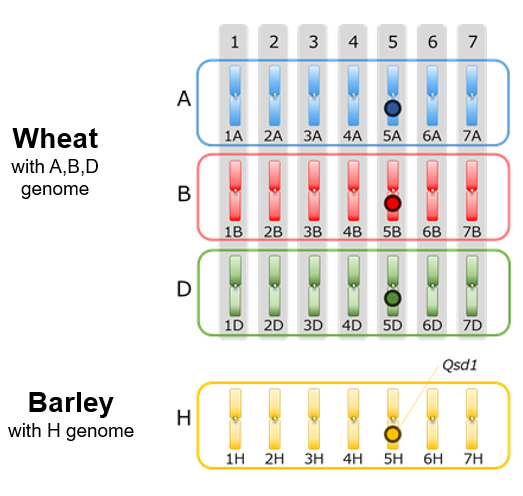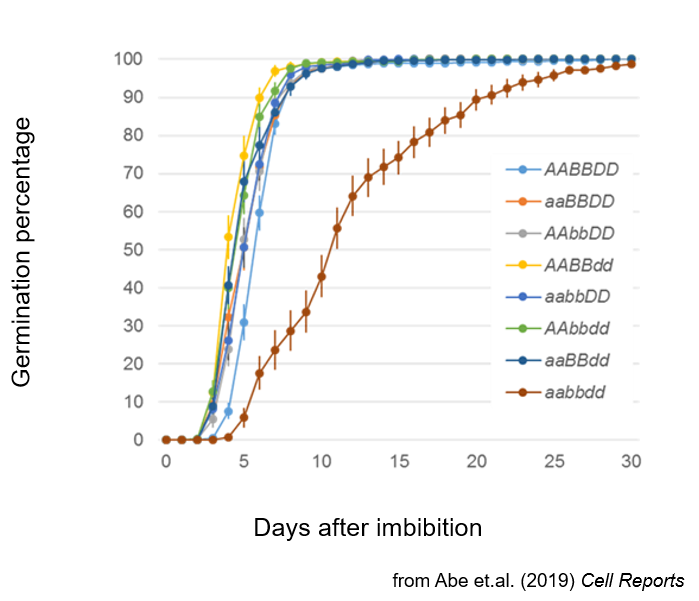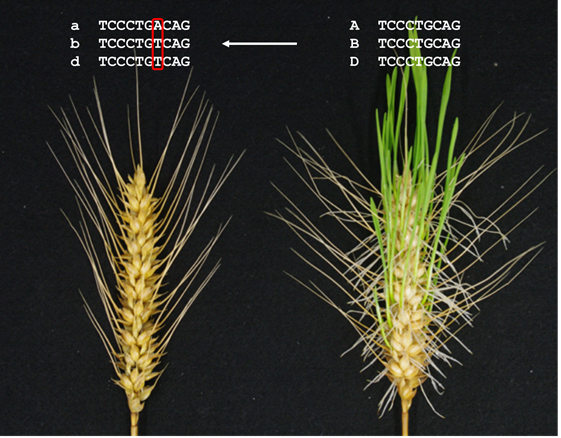Okayama University
NARO
Highlights
- Succeeded for the first time in improving wheat characteristics domestically using genome editing
- It was shown that the wheat traits can be improved by genetic/locus information of barley.
- All three genes with the same role could be modified in about a year.
Overview
The joint research group consisting of Prof. Kazuhiro Sato, Institute of Plant science and resources, Okayama University and Dr. Fumitaka Abe, Senior researcher, Institute of Crop Science, NARO, has succeeded in developing a plant that is difficult to germinate (long dormancy) even if it gets wet at the harvest time, in a short period of time by using genome editing technology to improve the characteristics of wheat. The genetic information found in barley with simpler genomes was very useful for improving the characteristics of wheat with complex genomes. This technique, based on the genetic information of other plant species, is attracting attention as a technology to transform overlapping genes at once to create new characteristics in wheat. This research result will be published on July 30 (11:00 AM East Coast Time) in the electronic version of "Cell Reports".
In the areas of Japan and Northern Europe etc. with abundant rainfall during harvest, some varieties have a short dormancy and hence sprouting of grains occurs on spikes, causing great damage to wheat production.
Since few genetic resources among wheat are available to support the improvement of pre-harvest sprouting resistance, this research result indicates the possibility of efficient wheat cultivar development utilizing genetic information of plants such as barley.
For Inquiries
Contact: http://www.naro.go.jp/english/inquiry/index.html
Publication:
Genome-edited triple recessive mutation alters seed dormancy in wheat.Cell Reports. Fumitaka Abe1, Emdadul Haque1, Hiroshi Hisano2, Tsuyoshi Tanaka1, Yoko Kamiya3, Masafumi Mikami4, Kanako Kawaura3, Masaki Endo4, Kazumitsu Onishi5, Takeshi Hayashi11 and Kazuhiro Sato2
Affiliation
1 - Institute of Crop Science, NARO, Tsukuba, 305-8518, Japan
2 - Institute of Plant Science and Resources, Okayama University, Kurashiki, 710-0046, Japan
3 - Kihara Institute for Biological Research, Yokohama City University, Yokohama, 244-0813 Japan
4 - Institute of Agrobiological Sciences, NARO, Tsukuba, 305-8602, Japan
5 - Department of Agro-Environmental Science, Obihiro University of Agriculture and Veterinary Medicine, Obihiro, 080-8555, Japan
URL - http://cellreports.cell.com
DOI - https://doi.org/10.1016/j.celrep.2019.06.090
Reference Information

Fig.1 Wheat and barley are said to have divided about 3 million years ago from their common ancestor, where wheat has 3 sets and barley has 1 set of similar genomes each consisting of seven pair of chromosomes. It was already known that the fifth (5H) chromosome of barley has Qsd1 that changes seed dormancy (○ sign), but in wheat, gene sequences with the same ancestor were not known to have the effect of changing seed dormancy.

Fig.2 Gene of A, B, D genome and Delayed seed germination of individuals
with mutated a, b and d (dormancy level).

Fig.3 Delayed germination due to seed dormancy of plants(left)
with mutations in the A, B and D genomes




